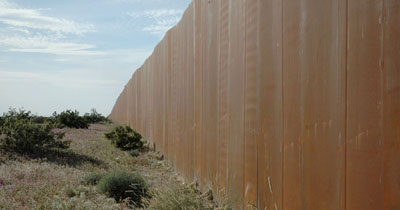Can the “Great Wall of Trump” be Made to Pay for Itself?
Gary Anderson
Fixed fortifications are a testament to the stupidity of man.
-- George S. Patton

The statement above reflected Patton’s offensive view of the world. He also took part in the punitive expedition to Mexico prior to the American entry into World War I. The expedition didn’t catch Poncho Villa but it did end his depredations across the border. Donald Trump has not advocated an invasion of Mexico, but he has promised to build a wall to deter illegal immigrants. No matter what one thinks of President Trump, he has spent his first three weeks in office attempting to make good on his campaign promises. Consequently, we have to assume that he will order the construction of some sort of wall and will try to level some kind of import tax to make the Mexicans pay for it, as this was also a campaign promise. We’ll see how that works out for him. The bottom line is that there will very likely be some kind of barrier construction project.
Recently, a friend of mine made an innovative suggestion regarding a way to make the wall partially pay for itself. He is a retired energy executive. His thought is to put solar panels on both sides of the wall and sell the resulting electricity to communities on both sides. He admittedly is not an expert in the economics of solar power generation, but he believes that it might at least pay for long term maintenance of the barrier. It is worth considering.
Actually, barriers sometimes work. The much-maligned Maginot Line actually did its job. The Germans never breached it; indeed, they made no attempt to do so, they simply went around it. The French expected this and planned to maneuver to meet the flanking movement. The French failed to accurately judge the location of the attack and how quickly the Germans could carry it out. The line did its job. American military doctrine has always stressed that any obstacle needs to be covered by observation and fire. The law enforcement corollary to that is that the barrier needs to be covered by observation and quick apprehension. As a retired combat-experienced officer, our new Director of Homeland Security doubtless has figured that out already.
General Kelly most likely realizes that resourceful illegal immigrants and drug smugglers will find ways over and under the wall. The problem is locating and apprehending them when they do so. I have a little experience with this problem. In my last field command, the Border Patrol resourced Marines from my Okinawa-based unit to travel to the Mexican border to provide surveillance and reconnaissance assets to augment law enforcement. A decade later, I was acting as the Deputy Director of a Defense Department experimental program that loaned some advanced robotic air and ground sensors to the border patrol to test their efficacy for law enforcement operations.
In neither case did our military reconnaissance and surveillance assets have arrest authority or capability (in the case of the DoD sensors). The result of both efforts was that only about twenty percent of the sightings were successfully apprehended as law enforcement lacked a combination of officers and mobility to make the required arrests. An improved barrier system may slow the leakers, but it won’t stop them. More agents and better mobility will be needed, and that will cost money. That is where my friend’s idea may be useful. Building the wall is only one aspect of better protecting the border. Maintaining it and policing it will cost big bucks. An attempt to make it pay for itself, at least partially, should not be taken off the table arbitrarily.
Generating renewable energy is trendy these days, and the ability to provide relative inexpensive power to both sides of the border may help to mitigate the political unpopularity of the wall among progressives. This may be a stretch, but it is a least worth considering.
I’d propose a study of the idea. Over the years, the government has studied subjects as goofy as the survival of the Snail Darter and the military feasibility of teleportation. Maybe looking at a proposal that may actually raise some revenue isn’t so outlandish after all.
